We'd been meaning to take a day trip to Brno for eons. Whenever the train pulls into Brno on our numerous trips between Bratislava and Prague, I'm always struck by the view from the station of the gothic cathedral of Ss Peter and Paul, with its pair of needle-thin spires that shoot dramatically into the sky, which sits atop a small hill in the center of town. The next thing you see from the train if you're heading in the direction of Prague is what looks like a big nuclear cooling tower, ringed by dilapidated old streets with torn up, abandoned couches and random articles of clothing strewn about the sidewalk. These things got me kind of curious to see what Brno is all about. Plus, we'd wanted to explore a Czech city other than Prague, for once, to get a taste of another part of the country and to see what life is like in a non-touristy city in the Czech Republic.
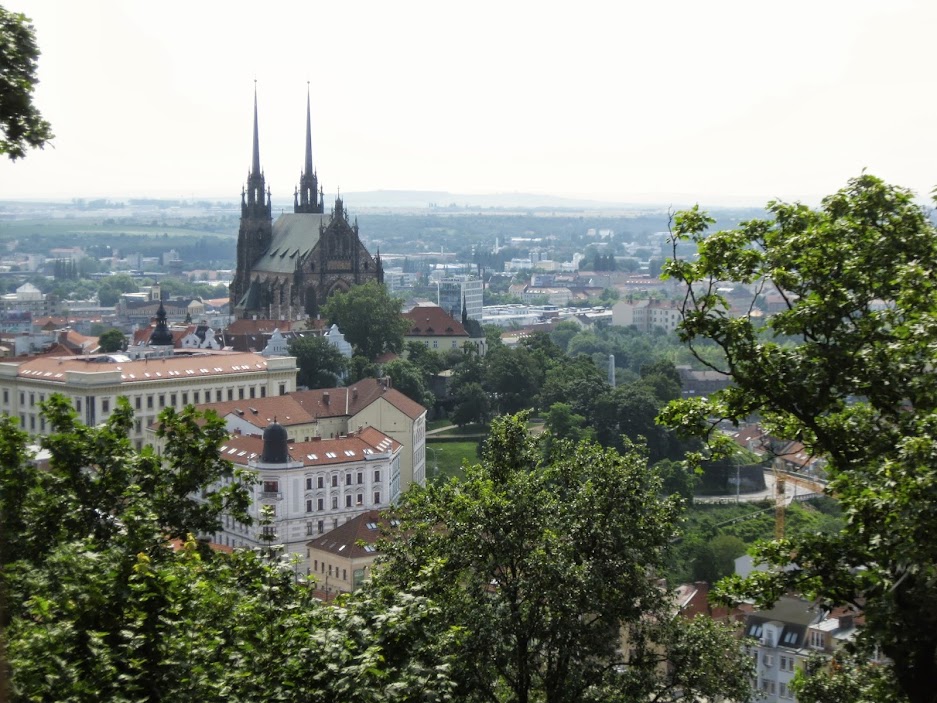 |
| Brno's main cathedral as seen from Špilberk castle |
Brno is the Czech Republic's second largest city and the capital of the Moravia region, and it's also kind of a halfway point between Bratislava and Prague. Brno is
not a huge tourist magnet (Rick Steves doesn't even mention it in his Eastern Europe book), and it's definitely not some undiscovered gem. While it does have a nice historical center and some other attributes (which I'll get to below), it's ultimately more of a workaday city with a lot of surrounding industrial sprawl and communist-era panelaks, but also a fair amount of green space and, apparently, a healthy university student population. It's actually tempting to draw comparisons between Brno and Bratislava, given that both cities are on the small side, with Brno having about 400,000 inhabitants (Bratislava has 450,000), both have similarly compact historical centers, and both seem to have a balance of historical splendor and contemporary urban grit.
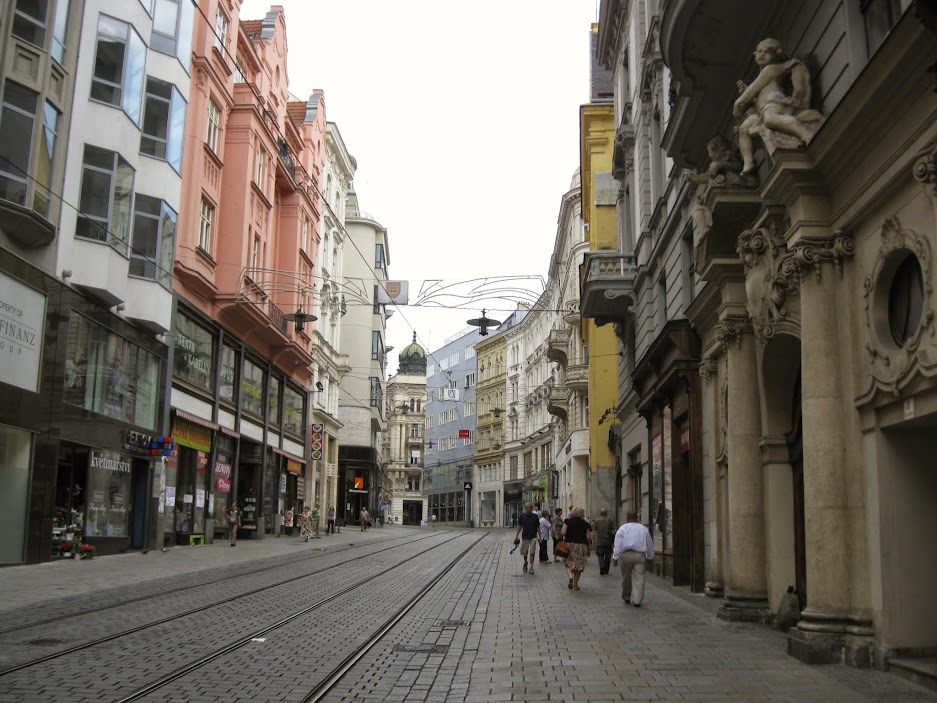 |
| Heading up Masarykova, Brno's main drag |
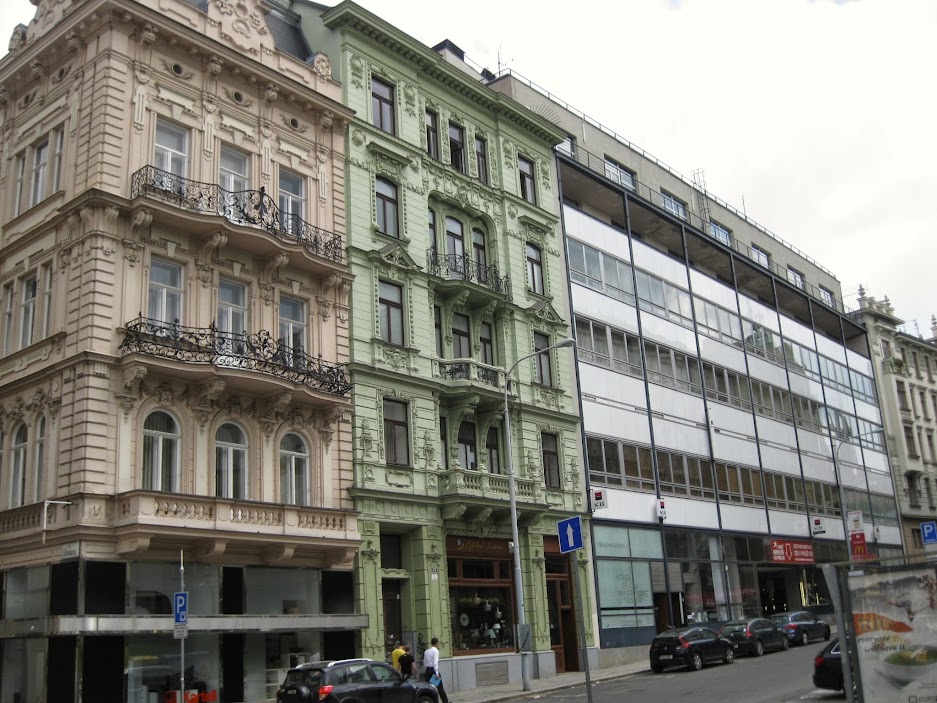 |
| Typical jumble of architectural styles in Brno |
But Brno lacks anything akin to Bratislava's quaint, fairytale pedestrianized historical center. While it does have the cathedral, Špilberk castle, the old town hall, and a few other compelling sites, it doesn't have anything like Bratislava's intimate and ornately colorful main square, and there appear to be precious few medieval, renaissance, or baroque buildings downtown. But much of what the city does have - a slew of 19th-century historicist and art nouveau buildings - is nevertheless pretty striking. In fact, Brno absolutely slays Bratislava in terms of its myriad drool-inducing art nouveau buildings (of which Bratislava has very few). Many of Brno's facades reminded us of the grand buildings in Vienna, with perhaps a dash of Budapest, which has the effect of making Brno seem a bit more, well, city-like than Bratislava, if that makes sense.

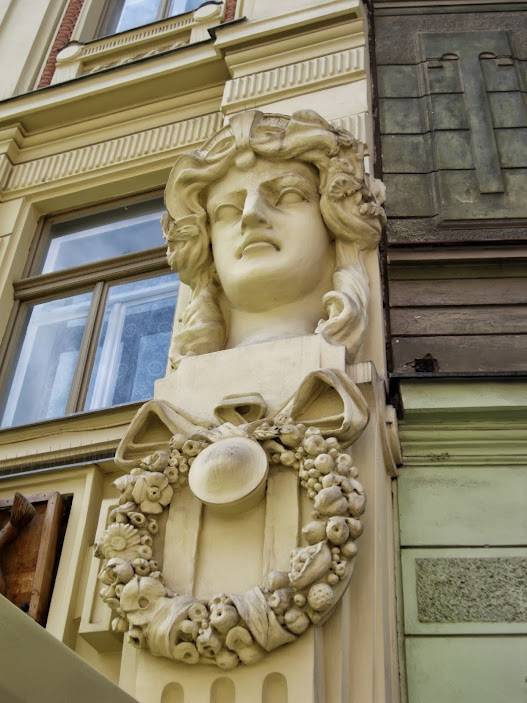
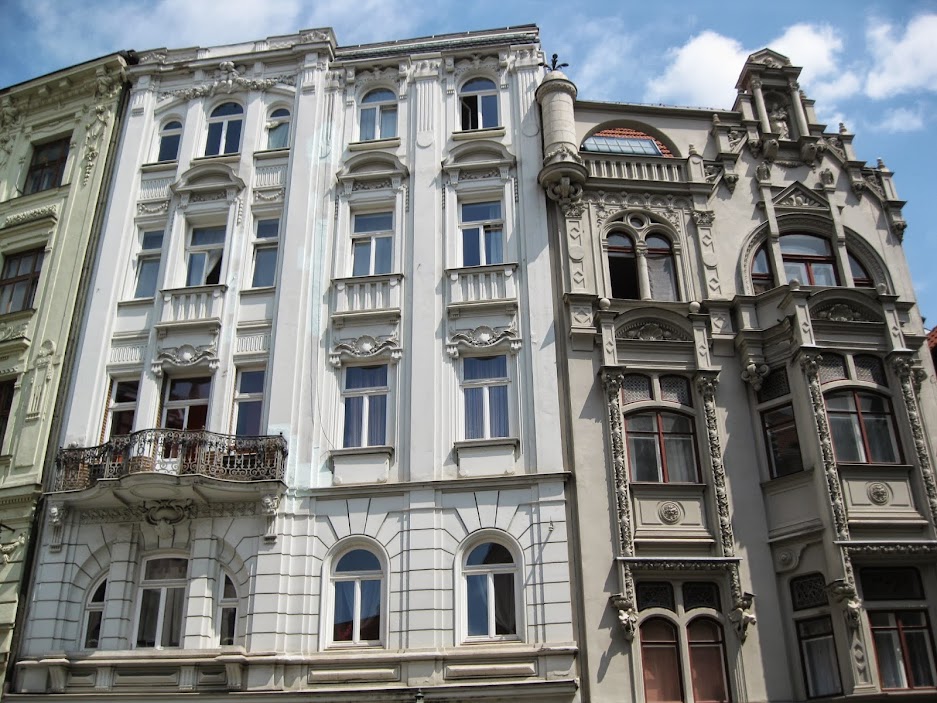
Brno's main square, Namesti Svobody (Freedom Square), is shaped a bit like a stingray. From the train station, you reach it by walking up Masyarkova, the main drag, which meanders gently up a gradual incline, and after three blocks opens up into the square. The square lacks the sort of over-the-top, dramatic historical facades and spires that line Prague's main square, yet the buildings on Namesti Svobody are still nice, and the square itself has a pleasant kind of energy to it, with lots of locals and only a handful of tourists sitting on its benches, playing around the interactive modern fountain, drinking pivo in the outdoor seating of any of the numerous pubs and cafes, or just milling about. When you look around at the square's buildings, you'll notice an interesting mix of old and new - grand and slightly goopy 18th and 19th century facades sit side by side with a few angular commie-era boxes and some sleek contemporary structures. Yet, nothing really sticks out in a jarring way; there's a relative sense of harmony.
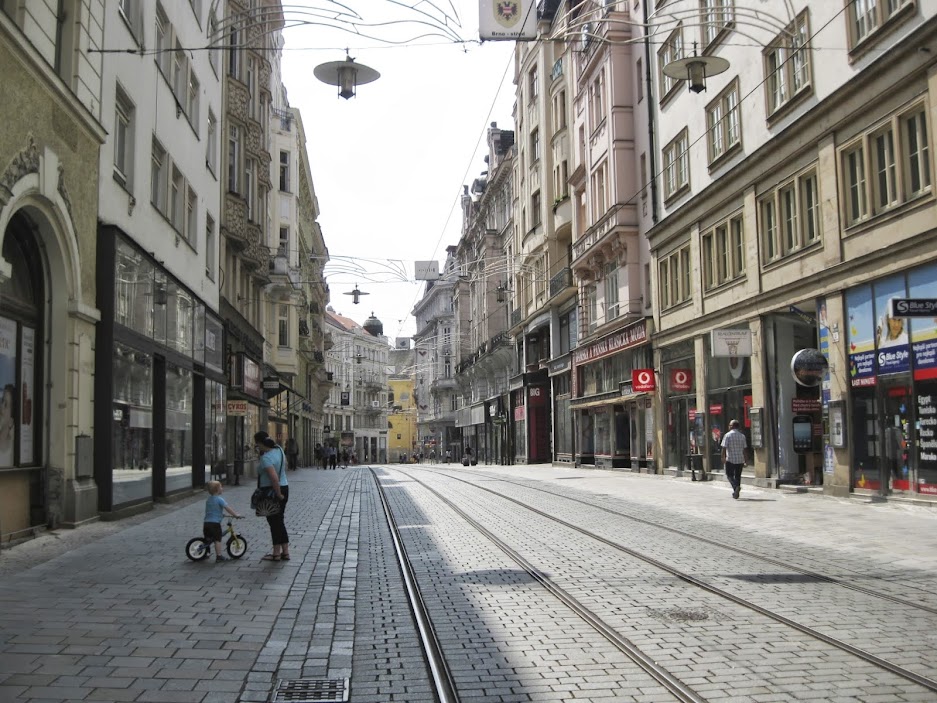
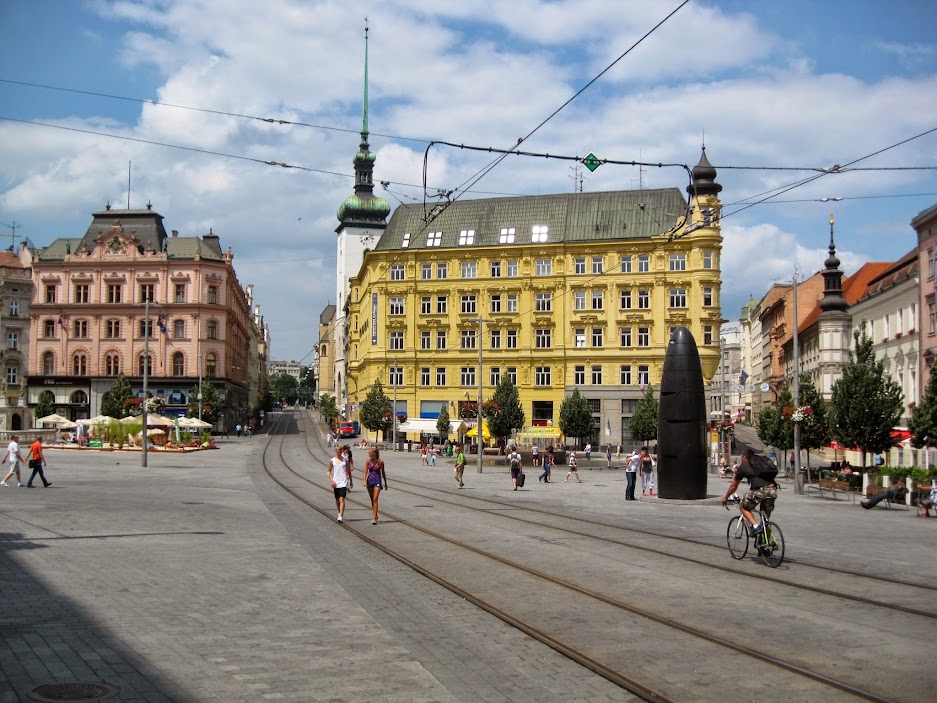 |
| Freedom Square, the heart of the historic center, with the needle-like spire of St. James cathedral in the background |
The square is interrupted by a tram line that runs right through its center, but the trams don't seem to harsh the generally mellow vibe too much.
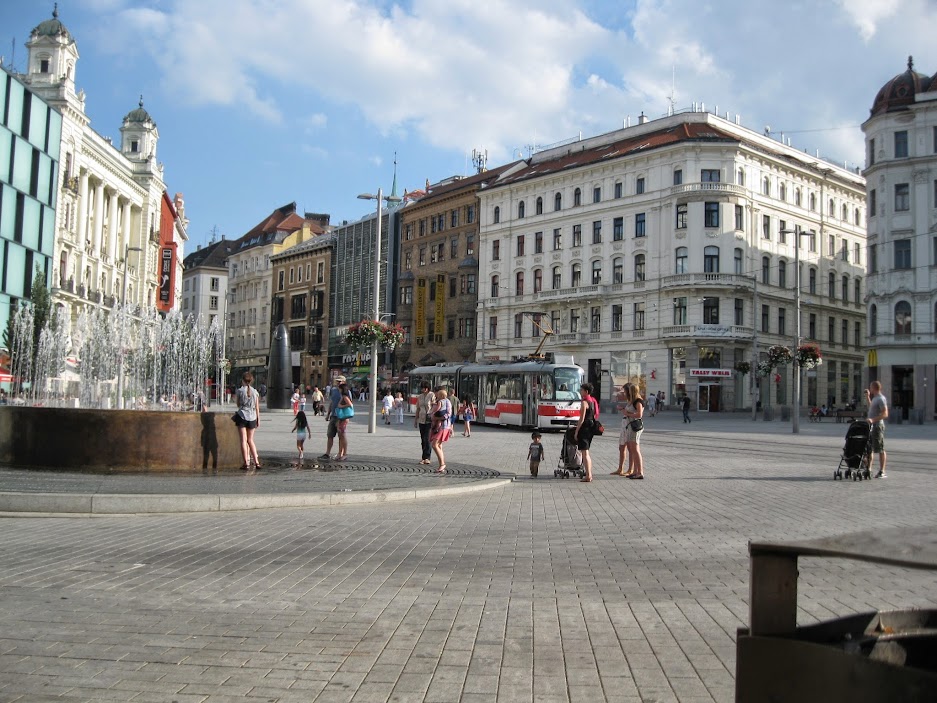 |
| Freedom Square, as seen from the outdoor seats of a local pub while imbibing some tasty local beer |
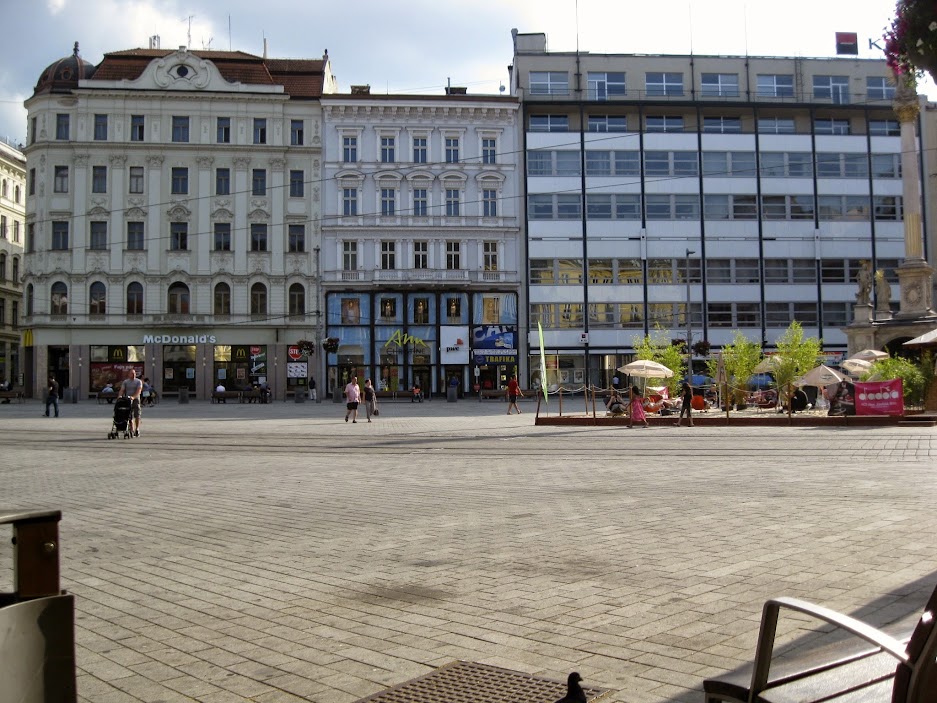 |
| Freedom Square |
A couple blocks away is Zelny trh (Green Market), another, presumably older square, which on most mornings has an outdoor produce market. Sadly, a good portion of this sprawling square is basically a parking lot these days.
 |
| Zelny trh, with the cathedral's spires rising in the background |
From Zelny trh it's just a couple of short and steep blocks up the hill to the cathedral of Ss Peter and Paul. Like a lot of cathedrals in Europe, the narrow lanes that surround it make it difficult to admire the thing without craning your neck. The best way to appreciate this cathedral's exterior is from a distance, where you can take it all in (preferably from the tower of the old town hall). It's a seriously beautiful cathedral, though. Brno may lack Bratislava's tranquil storybook center, but Bratislava's main cathedral, St. Martin's, absolutely pales in comparison to this thing. Unfortunately, the once-gothic interior was given a baroque make-over, and all of the masonry has been covered in yawn-inducing white plaster. They have a strict no camera policy inside (why are cathedrals in central Europe such camera nazis?), but it's not a particularly photogenic interior to begin with, so no big loss.
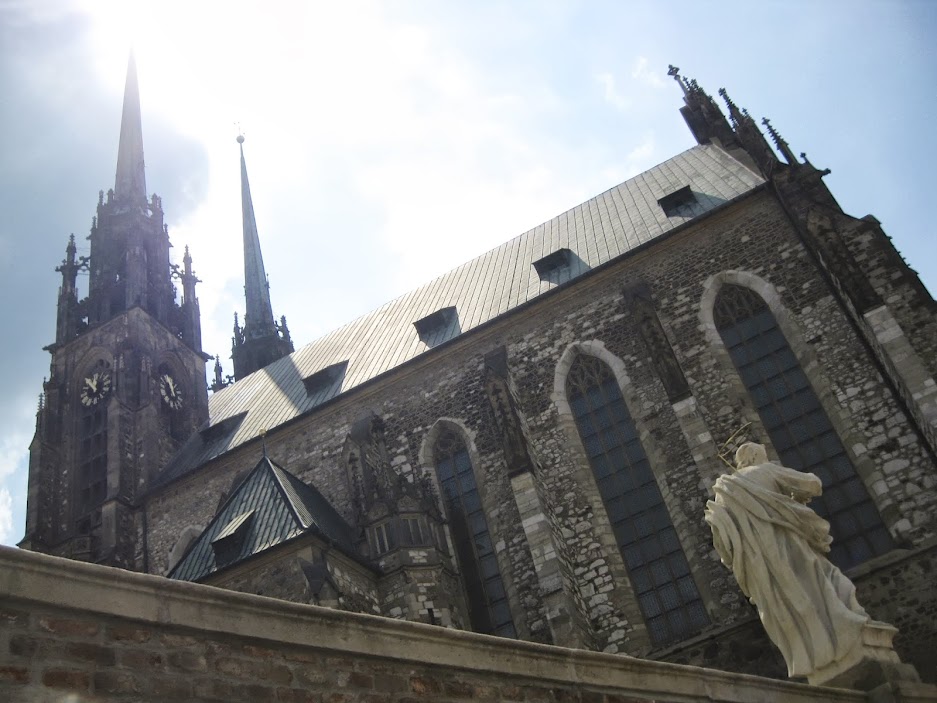 |
| Heading up to the cathedral |
 |
| On the narrow lane that runs around the cathedral |
Maybe it has to do with my extreme bitterness about not being able to ascend the tower of Kosice's cathedral when we were there back in May, but I was determined to climb every tower that was open in Brno, including those of its cathedral. However, the only tower in Brno that's really worth climbing is that of the old town hall, and that's partly because it offers awesome views of the cathedral, just 4-ish blocks away. But it also gives you a 360 view of the city, which you don't get from the cathedral's cramped little balconies.
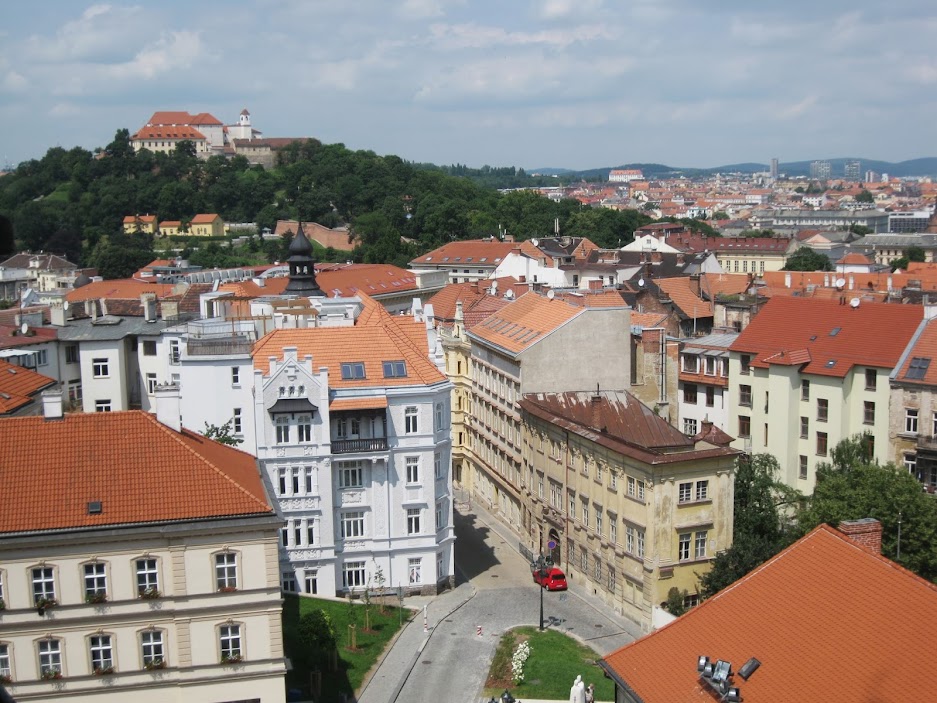 |
| Špilberk castle as seen from the cathedral tower |
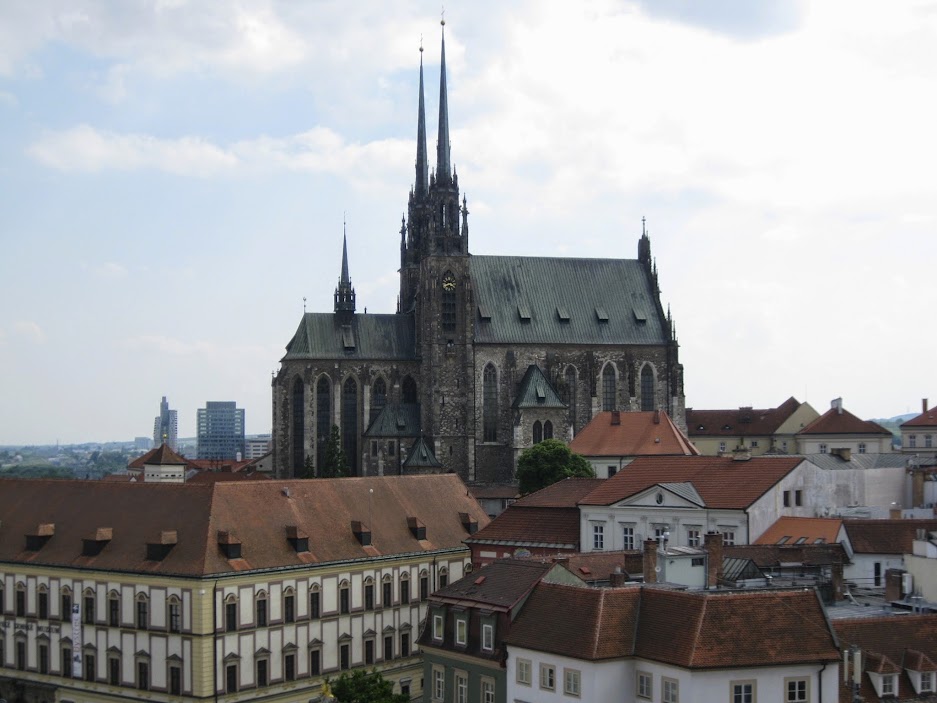 |
| The cathedral as seen from the town hall's tower |
 |
| Špilberk castle seen from the town hall's tower |
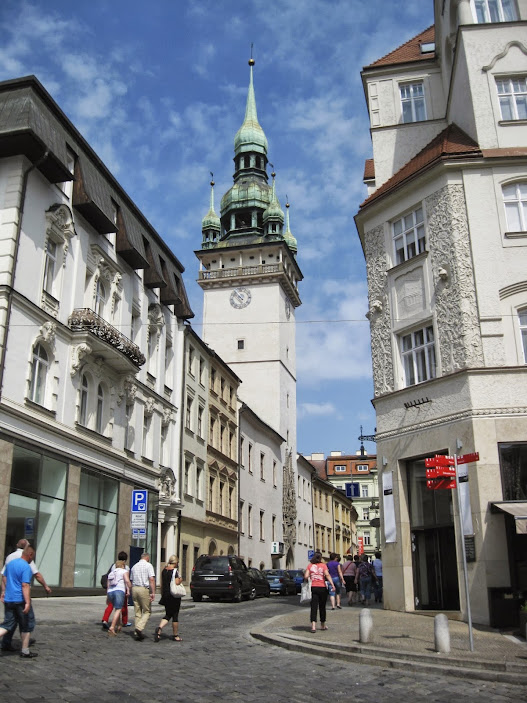 |
| The old town hall's tower |
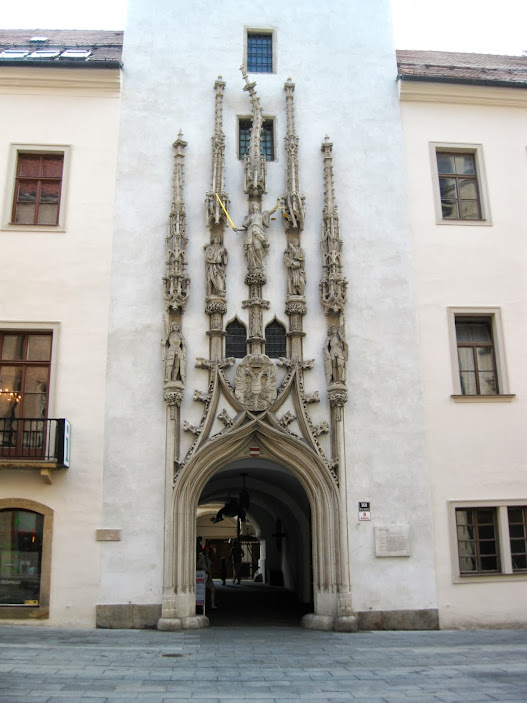 |
| Entrance to the old town hall (note the bent central spire) |
I mentioned earlier that just a stone's throw away from Brno's old town is what looks like a big nuclear cooling tower. It's actually a water cooling tower, as you obviously wouldn't see a nuclear power plant right smack in the center of a city. But I always associate that style of tower with the structures at nuclear power plants, so when I first saw the thing it definitely had me scratching my head. It's an amusing contrast from the cathedral and Špilberk castle, with which it shares the skyline.
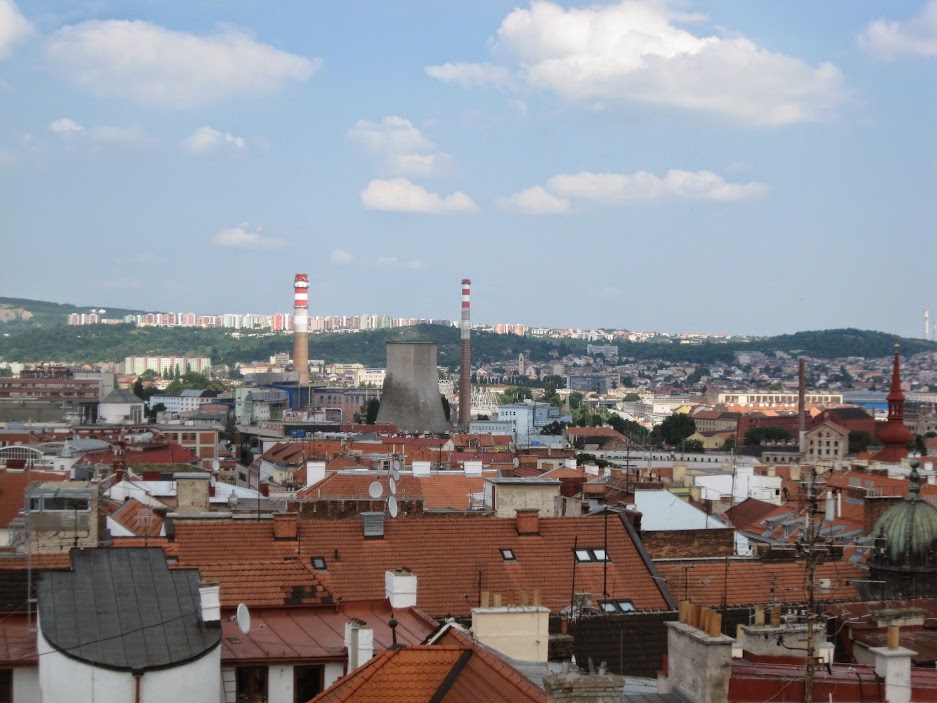 |
| Wait, is that a nuclear cooling tower in the middle of Brno? No, it's apparently a water cooling tower, but it still makes for an amusingly jumbled skyline. Notice all the communist-era panelaks that line the hills in the distance. |
Špilberk castle has an interesting and kind of gruesome history - its dungeon was a prison that became notorious for its squalid conditions. A lot of people involved in uprisings or rebellions against their Habsburg rulers were imprisoned here, including Italian poet
Silvio Pellico, who served 8 years here in the 1820s and somehow lived to write a book about it, which revealed for the first time to all of Europe just how awful conditions in the prison were.
 |
| Špilberk castle |
We weren't really interested in touring the various parts of the castle, but it's worth trekking up the hill and wandering around the nice park-like surroundings, especially for the views of the city. The castle itself is this relatively plain, white, plastered blob that's not very striking visually, kind of in the way that Bratislava's castle isn't all that interesting to look at, yet the fact that it's perched on the top of a hill makes it at least a little more compelling than it otherwise would be.
 |
| View of Brno from Špilberk |
Veveří street is absolutely worth a stroll for its endless cavalcade of goopy and pastel colored 19th-century historicist and art nouveau facades. The first 5-6 blocks that lead away from the historical center are quite striking, as are the side streets that branch off from this section of Veveří. The street is lined with basement-level restaurants, pubs, and wine cellars.
We also checked out the Capuchin monastery crypt, where, due to its dry, well-ventilated air and the composition of the soil, the people buried there were essentially mummified. So, you've got all of these corpses from the 18th century and earlier displayed in coffins with clear glass lids so you can see how their skin has been transformed into leather. Kind of amusingly gruesome.
 |
| The Capuchin crypt |
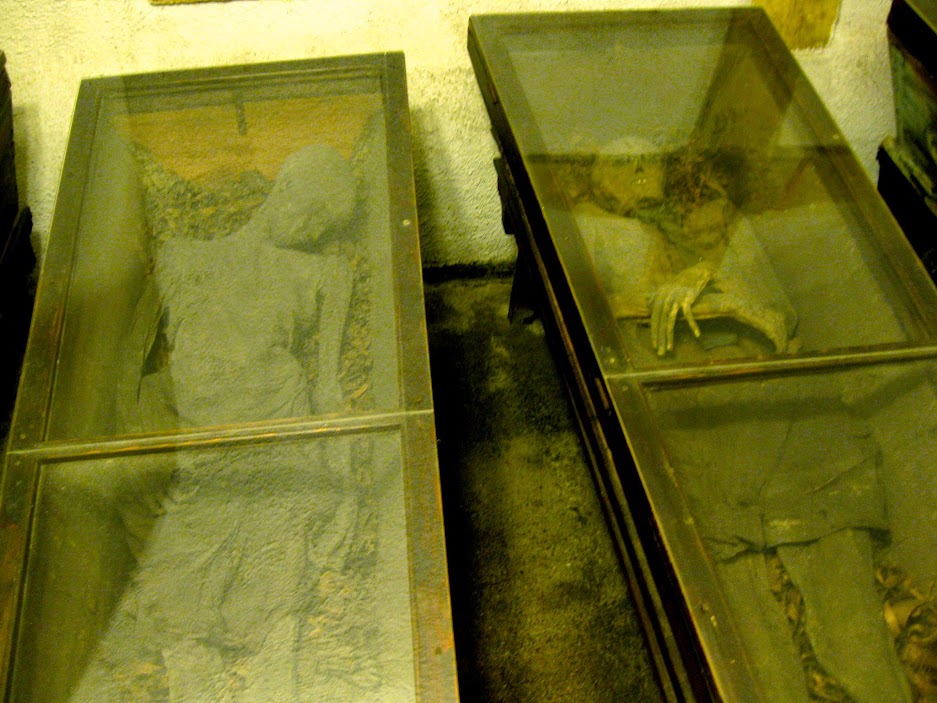 |
| The body on the left belonged to a woman who, according to the description, was most likely buried alive, albeit in an unconscious state after having contracted the plague or some such disease, as back then it was not standard practice to wait three days to make sure the person was really and truly dead. |
We didn't pay extra for reserved seats on the train like we usually do, because we were being noncommittal about when we wanted to go back. There was a 4:20 train and a 6:20 train, and wanting to be flexible, we thought we'd play it by ear and leave Brno when we felt like we'd had enough. The problem is that the 4:20 train involved a connection at Břeclav, the last stop before you cross into Slovakia, with only a few minutes to switch trains. That meant that if the train from Brno was late, we'd be stuck in Břeclav for a couple of hours until the next train, which was not a very exciting proposition. We headed to the station around 4:00 with the intention of taking the 4:20 train if it was on time, or skipping it and taking the 6:20 train if it was late. The 6:20 line was the crowded, direct line that runs from Hamburg through Prague and all the way to Budapest. Predictably, the 4:20 line was 10 minutes late, so no dice. But that meant that we had time to check out Brno's modern art museum.
The museum was definitely worth an hour or so of one's time, but there was initially some confusion about what the museum actually had on display. When we bought our tickets, the woman only told us to go to the second floor, so we figured that was where the bulk of the permanent collection was located. But when we got there, the entire floor (one large room) was given over to the work of one artist who does these amusingly perverse socio-political montages. The montages were loaded with Czech text, which I'm told was witty and sardonic, but not knowing Czech, I had to rely on the images to get the gist of what these pieces were about. Terezia asked the staff person in the room if there was anything else to see on the second floor, and she said no. We started feeling kind of ripped off; I mean, this is Brno's museum of modern art, and all there is to see are these high school-ish montage pieces?
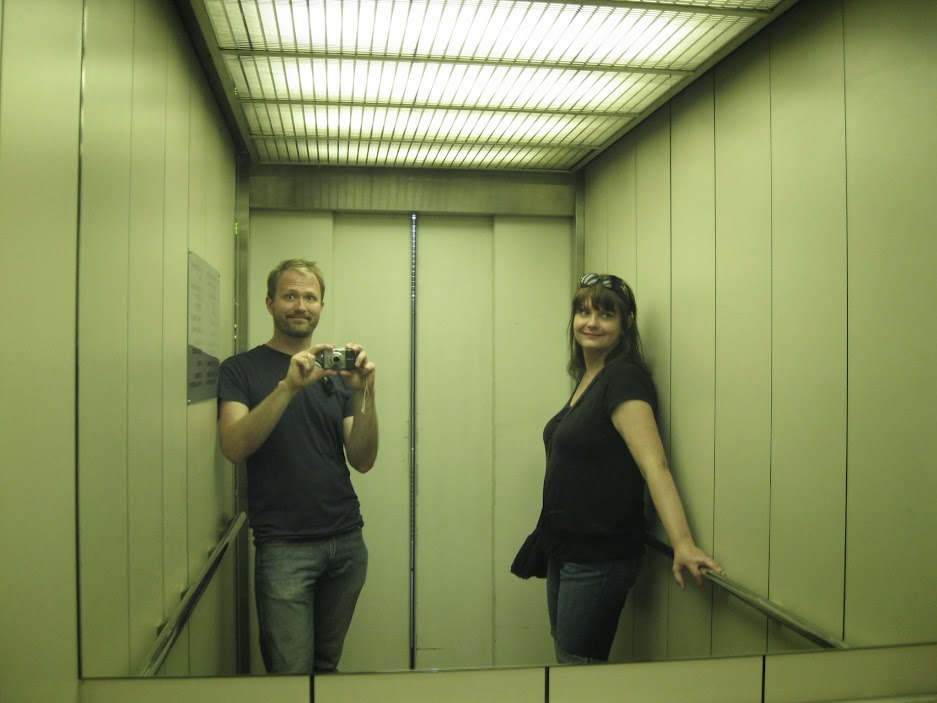 |
| In the elevator of Brno's modern art museum |
Thoroughly confused, we went back downstairs to the entrance and Terezia asked if there was anything to see in the museum other than the montages. As it turns out, there is an entire (and fairly sprawling) third floor, which houses their entire permanent collection. I suppose the woman meant for us to start on the second floor and then work our way up? Who knows! At any rate, overall it was a nice collection, with an emphasis on Czech impressionism and especially Czech cubism.
You had a lot of the usual suspects - Filla, Kubista, Prochazka, etc... - which we've seen in the museums in Prague as well as in a temporary exhibition in Bratislava last year. Ultimately, it wasn't as amazing as the
Museum of Czech Cubism or the
Museum of Modern Art in Prague, but still certainly worth the
€2.30 entrance fee.
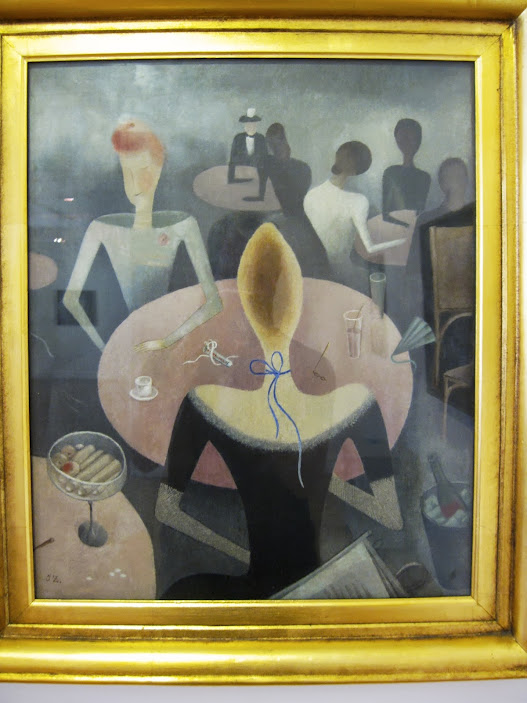 |
| A painting by Jan Zrzavý in Brno's modern art museum |
 |
| I think this one's by Emil Filla. |
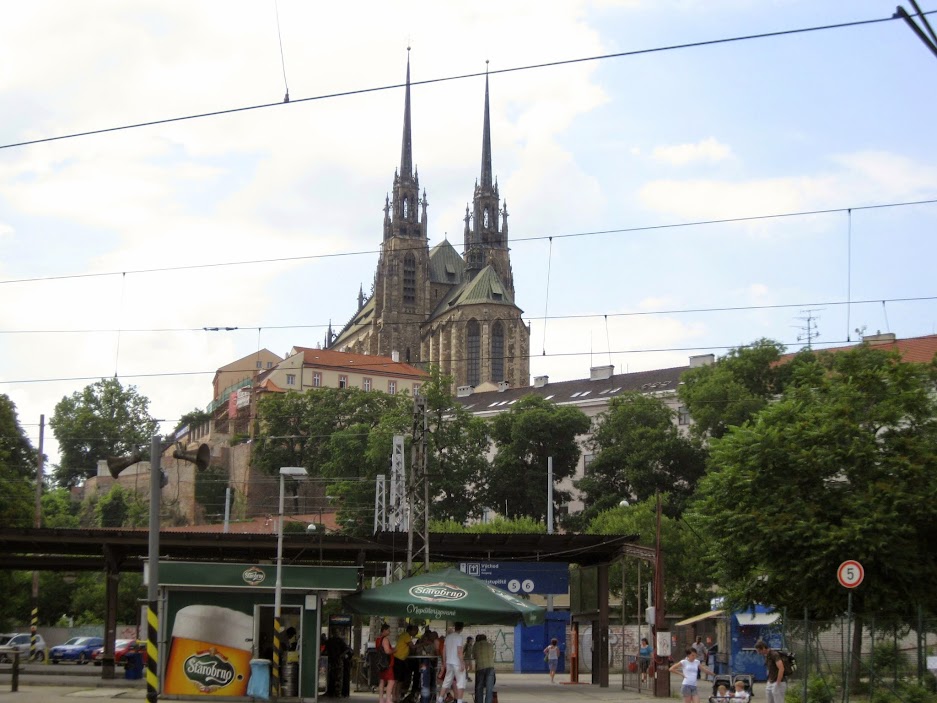 |
| The cathedral as seen from Brno's main train station |
When we got to the station to catch the 6:20 train, we were dismayed to discover that it was 35 minutes late. When the train finally pulled in, we deeply regretted not buying reserved seats, as every car was packed full of bummed-out, sweaty travelers, with people standing shoulder to shoulder in the corridors due to all seats having been taken. I kind of suspected that this might happen. After all, we're in the midst of the peak summer tourist season. But then again, I've been on this line during peak season in the past, and somehow managed to find seats. At any rate, we had to stand in the corridor at the end of a train car by the toilet for the entire hour and a half long ride back to Bratislava. Fun - especially since we'd been on our feet pretty much the
entire day and would've given anything to sit down at that point. Luckily, there was only one guy by us with
rank body odor, but you could really only smell it when he shifted around a lot; as long as he stood relatively still, things were bearable. A pretty unpleasant ride, obviously, and I don't think we've ever been
that happy to arrive back in Bratislava.
We think Brno is a good day trip destination. It obviously lacks Prague's wildly majestic visual appeal, but still has enough going for it to warrant a look around. And I think we saw enough of what we wanted to see to feel like we don't need to come back, at least not any time soon. It nevertheless felt like a livable city. The fact that there were so few tourists added to that livable factor. So while I can't say that we're clamoring to go back, we certainly dug getting the chance to explore a new (to us) city, which beats sitting around on our asses all day in Bratislava.
(Click here to see the full set of Brno photos!)
Lovely place
ReplyDelete